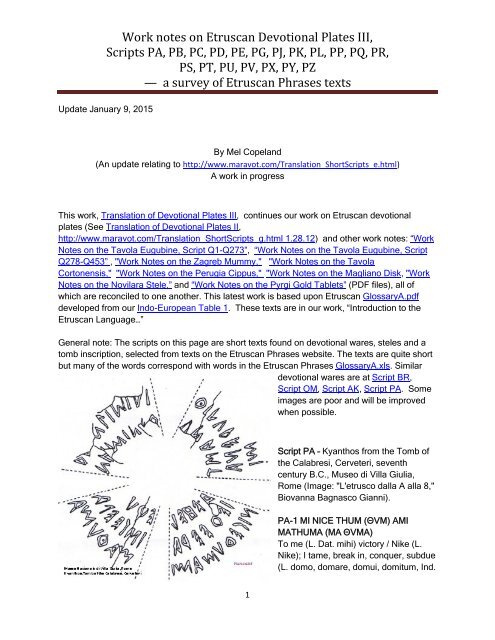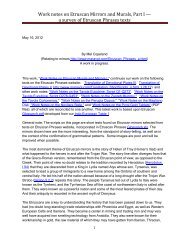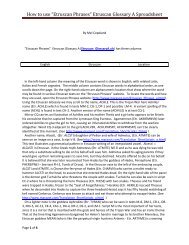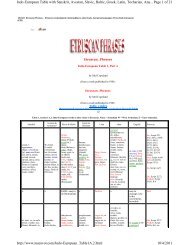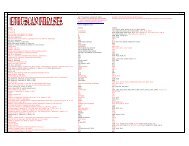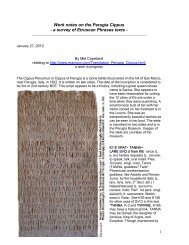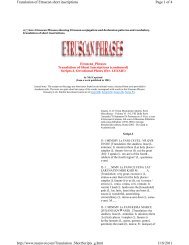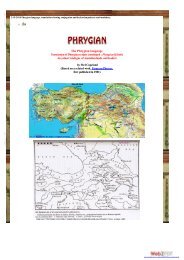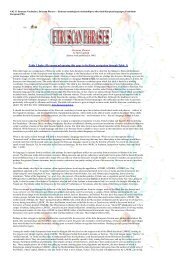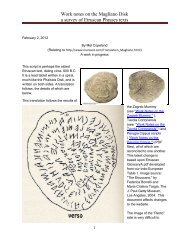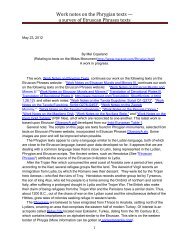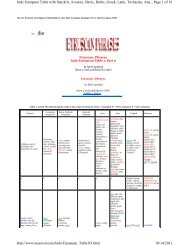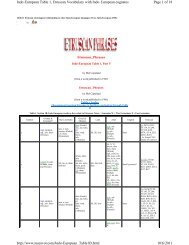Translation of Etruscan Devotional Plates III (PDF) - maravot.com
Translation of Etruscan Devotional Plates III (PDF) - maravot.com
Translation of Etruscan Devotional Plates III (PDF) - maravot.com
Create successful ePaper yourself
Turn your PDF publications into a flip-book with our unique Google optimized e-Paper software.
Work notes on <strong>Etruscan</strong> <strong>Devotional</strong> <strong>Plates</strong> <strong>III</strong>,<br />
Scripts PA, PB, PC, PD, PE, PG, PJ, PK, PL, PP, PQ, PR,<br />
PS, PT, PU, PV, PX, PY, PZ<br />
— a survey <strong>of</strong> <strong>Etruscan</strong> Phrases texts<br />
Update January 9, 2015<br />
By Mel Copeland<br />
(An update relating to http://www.<strong>maravot</strong>.<strong>com</strong>/<strong>Translation</strong>_ShortScripts_e.html)<br />
A work in progress<br />
This work, <strong>Translation</strong> <strong>of</strong> <strong>Devotional</strong> <strong>Plates</strong> <strong>III</strong>, continues our work on <strong>Etruscan</strong> devotional<br />
plates (See <strong>Translation</strong> <strong>of</strong> <strong>Devotional</strong> <strong>Plates</strong> II,<br />
http://www.<strong>maravot</strong>.<strong>com</strong>/<strong>Translation</strong>_ShortScripts_g.html 1.28.12) and other work notes: “Work<br />
Notes on the Tavola Eugubine, Script Q1-Q273”, “Work Notes on the Tavola Eugubine, Script<br />
Q278-Q453” , "Work Notes on the Zagreb Mummy," "Work Notes on the Tavola<br />
Cortonensis," "Work Notes on the Perugia Cippus," "Work Notes on the Magliano Disk, "Work<br />
Notes on the Novilara Stele,” and “Work Notes on the Pyrgi Gold Tablets” (<strong>PDF</strong> files), all <strong>of</strong><br />
which are reconciled to one another. This latest work is based upon <strong>Etruscan</strong> GlossaryA.pdf<br />
developed from our Indo-European Table 1. These texts are in our work, “Introduction to the<br />
<strong>Etruscan</strong> Language…”<br />
General note: The scripts on this page are short texts found on devotional wares, steles and a<br />
tomb inscription, selected from texts on the <strong>Etruscan</strong> Phrases website. The texts are quite short<br />
but many <strong>of</strong> the words correspond with words in the <strong>Etruscan</strong> Phrases GlossaryA.xls. Similar<br />
devotional wares are at Script BR,<br />
Script OM, Script AK, Script PA. Some<br />
images are poor and will be improved<br />
when possible.<br />
Script PA – Kyanthos from the Tomb <strong>of</strong><br />
the Calabresi, Cerveteri, seventh<br />
century B.C., Museo di Villa Giulia,<br />
Rome (Image: "L'etrusco dalla A alla 8,"<br />
Biovanna Bagnasco Gianni).<br />
PA-1 MI NICE THUM (ΘVM) AMI<br />
MATHUMA (MA ΘVMA)<br />
To me (L. Dat. mihi) victory / Nike (L.<br />
Nike); I tame, break in, conquer, subdue<br />
(L. domo, domare, domui, domitum, Ind.<br />
1
Work notes on <strong>Etruscan</strong> <strong>Devotional</strong> <strong>Plates</strong> <strong>III</strong>,<br />
Scripts PA, PB, PC, PD, PE, PG, PJ, PK, PL, PP, PQ, PR,<br />
PS, PT, PU, PV, PX, PY, PZ<br />
— a survey <strong>of</strong> <strong>Etruscan</strong> Phrases texts<br />
Pres. 1 st Pers. singl. domō ) friends (L. amicus, amica, 2nd Decl. Nom. pl. m, -i; It. amico,<br />
amica; Fr. amie-e) Maduma, name?<br />
Note: The Θ, Gr. delta, tends to read as a “d,” which appears to be the correct application in this<br />
case.<br />
PA-6 AE _N LISIAI THIPO (Θ IPV) RENA ....the camp followers (L. lixa-ae) by Thebes, city<br />
in Boeotia? (L. Thebae-arum, 2 nd Decl. Abl. -o) he/she rules, supports (L. regno-are; rego,<br />
regere; Ind. Perf. 3rd pers. singl. regnat)<br />
PA-10 IERE ERA ISTE EPA yesterday (L. heri; It. ieri; Fr. heir) mistress (L. era-ae, f.) that <strong>of</strong><br />
yours (L. iste, ista, istud) she spies, watches out for? (L. speculor-ari; it. spiare; Fr. épier)<br />
PA-15 NAMINER UNAS (VNAS) TAF8E<br />
LERO (LERV) to name, nominate (L.<br />
nomino-are, nomen-inis, name; Fr. nommer,<br />
It. nomanare loads, burden, weights;<br />
troubles, charges; public burdens, taxes (L.<br />
onus-eris, 1st decl. Acc. pl. -as) the trumpet<br />
(L. tuba-ae, 3 rd Decl. Abl. singl. -e, the straight<br />
war-trumpet <strong>of</strong> the Romans) by triumph,<br />
victory? (L. laurus-i 2 nd Decl. Abl. –o)<br />
Script PB — Kyanthos from the Tomb <strong>of</strong> the<br />
Duke <strong>of</strong> Vetulonia, Museo Topographico<br />
dell'Etruria, Florence (Image: "L'etrusco dalla A alla 8," Biovanna Bagnasco Gianni).<br />
PB-1 MINIMU (MINIMV) LO FANI PEUV, PEUB (PEF8) for, to the minimul, the least (L.<br />
minimus, 1st & 2nd. Decl. -o ; It. minimo) <strong>of</strong> them, it (L. id, ille, illa, illud; It. lo) <strong>of</strong> the temples (L.<br />
fanum-i) youth, adult male population (L. pubes-is)<br />
Note: MINIMV appears at: T-7, PB-1,J1-1, J2-1, J3-1, J8-1, J9-1, J12-1, J-13-1<br />
PB-5 LAKONAI (LAKVNAI) E FENE Le Laocoon, a Trojan priest (L. laocoon-ontis) or Spartan<br />
(L. Laco, [Lacon]-onis) from, out <strong>of</strong> (L. e) he will <strong>com</strong>e, arrive (L. venio, venire, Ind. Fut. veniet;<br />
It. venire; Fr. venir) there (Fr. le, la)<br />
2
Work notes on <strong>Etruscan</strong> <strong>Devotional</strong> <strong>Plates</strong> <strong>III</strong>,<br />
Scripts PA, PB, PC, PD, PE, PG, PJ, PK, PL, PP, PQ, PR,<br />
PS, PT, PU, PV, PX, PY, PZ<br />
— a survey <strong>of</strong> <strong>Etruscan</strong> Phrases texts<br />
Script PC – Kyanthos from Tomb BB6,<br />
Necropolis <strong>of</strong> Casone di Monteriggioni,<br />
Museo Guarnacci, Volterra. (Image:<br />
"L'etrusco dalla A alla 8," Biovanna<br />
Bagnasco Gianni).<br />
PC-1 NAIEM E ORO (VRV) ITHAL<br />
(IΘAL) THI (ΘI?) LENI THALIO (ΘALIV)<br />
E ME MESNA MERTAN SIN AM OLO<br />
(VLV) Gnaeus, Roman prenomen,<br />
shortened, Cn (L. Gnaeus-i, 2 nd Decl.<br />
Acc. singl. –um), from, out <strong>of</strong> (L. e, ex) I<br />
speak, I speak (L. oro-are, Ind. Pres. 1 st<br />
Pers. singl. ōrō) Italian (Itali-orum and -<br />
um, the Italians; Italia-ae, Italy, Italicus<br />
and Italus-a-um, Italian, adj.; Fr. Italian) to you (L. tu; te, Accus; vos, tibi; It. te, ti, to you; Fr. te, to<br />
you) I relieved, made mild, made lenient (L. leno-ire, Ind. Perf. 1st Pers. singl., lenuī;)<br />
retaliation (L talio-onis) from, by (L. e, ex) by, from me (L. Abl. me) Messana (L. Messana-ae,<br />
town in Sicily, person’s name, Messana?) Mertan, name? or alternatively they deserve, merit<br />
(L. mereo-ere, Ind. Conj. 1st Pers. singl. mereant, meritus-a-um) but if, if however, (L. sin) I<br />
love, like (L. amo-are, Ind. Pres. 1st Pers. singl. amō) the oil (L. oleum-i, 2nd Decl. Abl. singl. -o;<br />
It. olio; Fr. huilel)<br />
Script PD – Oniochoe.<br />
PD-1 VSA MILO (MILV) THUMAS (ΘVMAS) PHVTVM the<br />
mouths (L. os-oris, 2 nd Decl. Nom. pl. n. –a) by a thousand (L.<br />
mille - milia [millia], 2 nd Decl. Abl. singl. -o) you tame, break<br />
in, conquer (L. domo, domare, domui, domitum; domas 2nd<br />
pers. sing. present) warmed (L. foveo, fovere, fovi, fotum, to<br />
warm, keep warm, caress, to stay constantly in a place;<br />
particle, fotus)<br />
Note: In a Phrygian shard we have MILAS<br />
(See Phrygian1.html)<br />
3
Work notes on <strong>Etruscan</strong> <strong>Devotional</strong> <strong>Plates</strong> <strong>III</strong>,<br />
Scripts PA, PB, PC, PD, PE, PG, PJ, PK, PL, PP, PQ, PR,<br />
PS, PT, PU, PV, PX, PY, PZ<br />
— a survey <strong>of</strong> <strong>Etruscan</strong> Phrases texts<br />
Script PG, Aryballos, bucchero (Image: "L'etrusco dalla A alla<br />
8," Biovanna Bagnasco Gianni).<br />
PG-1 SI LARFAI ATELICLES LEKTVM VTA if, supposing<br />
that (L. si; It. se, Fr. si) the ghosts, spectres(L. larva (larua) -ae) <strong>of</strong> the Ateli Ateli, name, (L.<br />
Attalus-i, adj. Attalicus-a-um, name <strong>of</strong> several kings <strong>of</strong> Pergamum; or Atelicles, chosen,<br />
excellent (L. lectus-a-um) he is at leisure, (L. otior-ari, Ind. Pres. 3 rd Pers. Conj. otiat)<br />
Note: The "F" faces towards the word to which it belongs. Some <strong>Etruscan</strong> texts used this<br />
technique to separate words. The final "S" in Atelicles also faces the word to which it belongs.<br />
Script PE, Aryballos, ceramic (Image:<br />
"L'etrusco dalla A alla 8," Biovanna Bagnasco<br />
Gianni).<br />
PE-1 MvLAKAS: SELA: ASKA MIELE IUAN<br />
(IFAN) you make gentle, s<strong>of</strong>ten (L. mollescoere,<br />
Ind. Conj. 2 nd Pers. singl. mollēscās); the<br />
chair, seat (L. sella-e; It. selle; Fr. selle, seller,<br />
to saddle) by food (L. esca-ae, Abl. singl. -a) the<br />
honey (L. mel, mellis; It. miele) <strong>of</strong> Euan, (L.<br />
Euan or Euhan, a name <strong>of</strong> Bacchus)<br />
Note: This vase no doubt was used to pour wine, in which case we would read: "You s<strong>of</strong>ten the<br />
seat <strong>of</strong> food the honey <strong>of</strong> Bacchus / Dionysus”<br />
Script PQ, Tablet Museo Civico, Viterbo. Note: As can be<br />
discerned in looking at the tablet's two borders, there<br />
appears to be a missing section <strong>of</strong> the tablet adjoining the<br />
right-hand side.<br />
PQ-1 PIPE SI CALE ...Pipe (unknown word; first word may<br />
be tipe, type, model); himself, herself, itself (L. se, sese; It. si;<br />
Fr. se) he summons (L. calo-are, Ind. Conj. 3 rd Pers. singl.<br />
calet)<br />
4
Work notes on <strong>Etruscan</strong> <strong>Devotional</strong> <strong>Plates</strong> <strong>III</strong>,<br />
Scripts PA, PB, PC, PD, PE, PG, PJ, PK, PL, PP, PQ, PR,<br />
PS, PT, PU, PV, PX, PY, PZ<br />
— a survey <strong>of</strong> <strong>Etruscan</strong> Phrases texts<br />
PQ-4 CINA VS MES he burns, incinerates he burns, incinerates (L. incendo-cendere; Conj.<br />
Pres. 3rd Pers. singl. incendat) the bone (L. os, ossis, bone; It. osso, bone; Fr. os, bone) you<br />
pass (L. meo, meare, to go, pass; 2nd pers. pres. mes)<br />
PQ-7 PHvNTH (ØvN Θ) NAPER the fountain? (L. fontanus-a-um; fons, fontis, spring; It. fonte,<br />
Fr. fonte) <strong>of</strong> Naper, name <strong>of</strong> a queen in Perugia Cippus, Script K K75. K82, K131. (The<br />
character "P" is not a "t" in this case; <strong>com</strong>pare with TRE, line PQ-13):<br />
K79 (F)EL RINA HVT NAPER PENEIS the great queen (L. regina, f.; It. regina, f.; Fr.<br />
reine, f.) high, l<strong>of</strong>ty, eminent, important (Fr. haut; hausser, to raise, lift) Naper, name? <strong>of</strong><br />
Peneis, place, River Peneus in Thessaly, Greece, also the river god, Peneius, father <strong>of</strong><br />
the nymph Daphne?<br />
K129 HE Se NAPER CI CN Le HAREV TVSE you have (L. habeo-are) itself, herself<br />
(L. se, sese; It. si; Fr. se) Naper, name; who, which (L. qui, quae, quod; It. chi; Fr. qui)<br />
CN (L. Cn, Cnaeus-i, abbreviation <strong>of</strong> name, Cnaeus) there (le) I draw out, empty (L.<br />
haurio, haurire, Ind. Pres. 1 st Pers. singl. hauriō) leader, ruler (L. dux, ducis, 3rd Decl.<br />
Abl. singl. -e)<br />
PQ-9 LEIEM RVI to the lioness (L. lea-ae and laena; 1st decl. Acc.) king, regent (L. rex, regis;<br />
It. re; Fr. roi)<br />
PQ-11 ARAS ATHEN (A ΘEN) altars (L. ara-ae; 1st Decl. Accus. pl. -as) from Athens?<br />
Athens, Athena, Athenian (L. Athenae-arum; Athenaeus-a-um; Atheniensis-e)<br />
Note: The end <strong>of</strong> "Athen" may be on the missing sectionor the “S” at PQ-13, i.e., 1 st Decl. Abl.<br />
pl. –is: ATHENiS.<br />
PQ-13 S (S to line PQ-11) CLAEI: TRE Cleo, the muse <strong>of</strong> history (L. Clio-us; possibly 5th<br />
Decl. gen.-ei; See ELINEI, Helen <strong>of</strong> Troy's name, and PHERSIPNEI, Gr. goddess Persephone)<br />
three (L. tres, tria; It. tre; Fr. trois; Toch., tri, traiy; Gr. tria; Welsh, tri, tair). Note: Claei is<br />
undoubtedly a noun. Tre refers to the next line, because <strong>of</strong> the separating punctuation.<br />
PQ-16 THEN (ΘEN) SVME Tridens (L. tridens-entis, having three teeth or prongs; m. as a<br />
subst. a three-pronged spear) sume, we are (L. summus; It. siamo; Fr. sommes)<br />
5
Work notes on <strong>Etruscan</strong> <strong>Devotional</strong> <strong>Plates</strong> <strong>III</strong>,<br />
Scripts PA, PB, PC, PD, PE, PG, PJ, PK, PL, PP, PQ, PR,<br />
PS, PT, PU, PV, PX, PY, PZ<br />
— a survey <strong>of</strong> <strong>Etruscan</strong> Phrases texts<br />
Script PJ, ceramic dish, Cerveteri, Museo Nazionale (Image:<br />
"L'etrusco dalla A alla 8," Biovanna Bagnasco Gianni)<br />
PJ-1 A MI FEXIES FETRAS To (L. a) to me, my (L. meus-aum;<br />
mihi, Dat. It. mi, myself) troop, <strong>com</strong>pany (L. vexillum-i, 2 nd<br />
Decl. Dat. pl. –isveterans, old soldiers (L. veteranus-a-um, 1st<br />
Decl Acc. pl. -as, 2nd Decl. Acc.-a)<br />
Script PK, Stele known as "Avil Tite," which we title, "Tities Oxiem."<br />
PK-1 MI AFILES TITEM OCHSIEM (V SIEM) VLIE NIKE to me (L. meus-a-um; mihi, Dat. It.<br />
mi, myself) suitable, fit (L. habilis-e, 3rd Decl. Nom. pl. -es) <strong>of</strong> the [tribe] Titem (L. Tities-ium; -<br />
em, 3rd Decl. Acc. -em) Oxiem, name? eighth? (L. octavus; It. ottavo, Fr. huitiem) the oil oil (L.<br />
oleum-i, 2nd. Decl. Gen. -i; It. olio; Fr. huile) <strong>of</strong> Nike [victory, goddess <strong>of</strong> victory]<br />
Note: The <strong>Etruscan</strong> peoples were organized in a<br />
Confederation <strong>of</strong> 12 cities, each perhaps being dominated by<br />
a tribe. Thus, if there were 12 tribes, this warrior may have<br />
belonged to the Eighth Tribe.<br />
6
Work notes on <strong>Etruscan</strong> <strong>Devotional</strong> <strong>Plates</strong> <strong>III</strong>,<br />
Scripts PA, PB, PC, PD, PE, PG, PJ, PK, PL, PP, PQ, PR,<br />
PS, PT, PU, PV, PX, PY, PZ<br />
— a survey <strong>of</strong> <strong>Etruscan</strong> Phrases texts<br />
Script PM<br />
PM-1 MI LARTHIA (LARΘIA) PHARSIES (ΘARSIES)<br />
to me (L. meus-a-um; mihi, Dat. It. mi, myself) name,<br />
Larthia, Pharsies<br />
PM-4 VCHVLEIM OCREO (VCREV) TIE eye (L.<br />
oculus-i; 3rd Decl. Acc. singl. -em) <strong>of</strong> a greave? (L.<br />
ocrea-ae; 2 nd Decl. Dat. singl. –o) <strong>of</strong> the day (L. day (L.<br />
dies-ei, day; diu, by day; diutiuus, longer; Welsh, dydd;<br />
Scot, di). Note: This man appears to be an augur<br />
carrying a torch<br />
7
Work notes on <strong>Etruscan</strong> <strong>Devotional</strong> <strong>Plates</strong> <strong>III</strong>,<br />
Scripts PA, PB, PC, PD, PE, PG, PJ, PK, PL, PP, PQ, PR,<br />
PS, PT, PU, PV, PX, PY, PZ<br />
— a survey <strong>of</strong> <strong>Etruscan</strong> Phrases texts<br />
Script PO, Tomba Scudi,<br />
Tarquinia<br />
PO-1 _N: SILAR: AM CE: MECH<br />
(ME ) Le: RASNA V(S) (S<br />
from PO-9) behold (L. en) to be<br />
silent (L. sileo-ere-ui; It. silenzio,<br />
silence; Fr. silence, silence); I<br />
love, like (L. amo-are, Ind. Pres.<br />
1 st Pers. singl. amō) wherewith,<br />
wherefrom (L. qui, old ablative <strong>of</strong> qui; qui, quae, quod, any, some; relat. who, which, what) me,<br />
with me, to me (It. mecco) there (Fr. le, la); the <strong>Etruscan</strong> (Etr. Rasna) bone (L. os, oris, mouth;<br />
os, ossis, bone; It. osso, bone; Fr. os, bone);<br />
PO-9 ORO (VRV)? ROSTIA CE: VCNTM: AFLE I speak (L. oro-are, Ind. Pres. 1st Pers. singl.<br />
ōrō ; Palaic, wer) Rostia, person's name (re: L. rosetum-i, a garden <strong>of</strong> roses wherewith,<br />
wherefrom (L. qui, old ablative <strong>of</strong> qui; qui, quae, quod, any, some; relat. who, which, what) I<br />
sing? (L. occento-are, to sing a seranade to; we sing, occentamus; Conj. pres. 1st person,<br />
occentem) the lord? Aule, <strong>com</strong>mon Latin name (L. aulicus-a-um, <strong>of</strong> the court, princely)<br />
PO-13 UN RV (FNRV) One (L. unnus-a-um, unius, uni, una; It. un) I bedew (L. roro-are)<br />
PO-15 BRINAI (8RINAI) Brinai, name<br />
Script PP Bowl from Populonia, necropolis <strong>of</strong> S. Cerbone, Museo Archeologico di Firenze, inv.<br />
80894. 1 PP-1 KARMV KA<br />
FLAS TVRKS We<br />
are without (L. careoere,<br />
to be absent<br />
from, be without; Ind.<br />
Pres. 1 st Pers. Pl.<br />
carḗmus) a packhorse<br />
(L. caballus-i)<br />
collar (L. torquis<br />
1<br />
8
[torques] – i)<br />
Work notes on <strong>Etruscan</strong> <strong>Devotional</strong> <strong>Plates</strong> <strong>III</strong>,<br />
Scripts PA, PB, PC, PD, PE, PG, PJ, PK, PL, PP, PQ, PR,<br />
PS, PT, PU, PV, PX, PY, PZ<br />
— a survey <strong>of</strong> <strong>Etruscan</strong> Phrases texts<br />
PP-4 KFI ITHA wherewith (L. qui) thus, so (L. ita)<br />
Note: We suspect the<br />
“- mo” suffix is Latin<br />
“mus.”<br />
Script PQ Bronze<br />
mirror, Vulci,<br />
discovered 1833,<br />
Museo Etrusco<br />
Gregoriano, inv.<br />
122611<br />
PQ-1 PINA AVSIN<br />
RII TVCE by the<br />
arrow, wing (L. pinnaae,<br />
Abl.. Single –a) lower Italy, in general, Italy (L.Ausonia-ae) the things (L. res-rei) from, by the<br />
Duke, leader, <strong>com</strong>mander (L. Dux-Ducis, 3 rd Decl. Abl. Single –e)<br />
PQ-PERSEN AS CALIA – Probably a proper name, Persenas Calia. The “ia” suffix indicates a<br />
proper name, as in Julia, Tinia, Unia, Tarquinia, Spinia, etc.<br />
Script PR Inscription from the left wall <strong>of</strong> a tomb, <strong>of</strong> “Anina,” Tarquinia.<br />
PR-1 FEL: ANINAS: FELVS: CLAN The great ANINAS, <strong>of</strong> the infantry (L. veles-itis, velites 2nd<br />
Decl. Acc. Pl. -os) the clan? (L. gens, tribus; It. tribu, Fr. clan, m.; Clanis River - runs through<br />
Clusium) Note: CLAN appears at VP-7, TC224. See<br />
9
Work notes on <strong>Etruscan</strong> <strong>Devotional</strong> <strong>Plates</strong> <strong>III</strong>,<br />
Scripts PA, PB, PC, PD, PE, PG, PJ, PK, PL, PP, PQ, PR,<br />
PS, PT, PU, PV, PX, PY, PZ<br />
— a survey <strong>of</strong> <strong>Etruscan</strong> Phrases texts<br />
http://www.<strong>maravot</strong>.<strong>com</strong>/<strong>Translation</strong>_Short_Scri<br />
pts.html Scripts AN which are similar, indented<br />
below. Because these texts begin with “Aninas”<br />
the question whether this is a name is arguable.<br />
PR-5 ATI ALC: AFILS: LVPV XXII to Attis (- i, 3 rd<br />
Decl. Dat. Single) someone, something (L.<br />
aliqua, aliqui) you are plucked away (L. avello,<br />
vellere, vexi, vectum, Ind. Pres. 2 nd Pers. Single<br />
avellis), by a wolf (L. lupus-I, 2 nd Decl. Abl.<br />
Single –o) (at the age <strong>of</strong>) 23. Note: AFILS<br />
declines and is used in the sense <strong>of</strong> “lived” and<br />
probably is “plucked away,” as the <strong>Etruscan</strong>s<br />
viewed their souls as being plucked away,<br />
carried in the arms <strong>of</strong> TVRMS (Mercury).<br />
(Image from<br />
http://www.<strong>maravot</strong>.<strong>com</strong>/<strong>Etruscan</strong>_Murals)<br />
AN-1 ANINAS: ARNO: FELVS: Aninas <strong>of</strong> the<br />
Arno (L. Arnus-i, 2 nd Decl. Abl. o) chief river <strong>of</strong><br />
Etruria, now the Arno) <strong>of</strong> the infantry (L. veles-itis, velites 2nd Decl. Acc. Pl. -os)….<br />
AN-12 ANINAS: FEL: FELVS: A PANES: SVR NVS Aninas the great <strong>of</strong> the infantry (L.<br />
veles-itis, velites 2nd Decl. Acc. Pl. -os) <strong>of</strong> (L. a) the cloth (L. pannus-i) sister (L. soror)<br />
our (L. nos; Fr. nos; It. nostro, nostri, nostra, nostre)…<br />
AN-34 ANINAS: LARO FELVS: ARS NAL Aninas: the ghost (L. arua [larua]-ae, f.) <strong>of</strong> the<br />
infantry (L. veles-itis, velites 2nd Decl. Acc. Pl. -os) the skill/character (L. ars-tis, f.) the<br />
passage money (L. naulum-i)<br />
AN-40 A PANES: SVRvM SIS CFS ICV CATES <strong>of</strong> (L. a) the cloth (L. pannus-i) for the<br />
sister (L. sister (L. soror-oris; 2 nd Decl. Single Acc. –um) It. suora; Fr. soeur; Tocharian,<br />
sar; Irish sier; Pers., xahar) wish, to be willing (L. sis = si vis; Fr. souhaiter) Cus (person’s<br />
name) to strike, slay (L. icio or ico, ici, ictum, Ind. Pres. 1 st Pers. Single iciō) <strong>of</strong> the family<br />
<strong>of</strong> Cato (L. Cates – 3 rd Decl. Acc. Pl. –es)<br />
AN-47 AN: FAC Le: LAFV TN: RAF SI whether (L. an) I make/do (L. facio, facere, feci,<br />
factum) there (le) to bathe (L. lavo, lavare, or lavere, livi, lautu or lotum or lauatum) <strong>of</strong> TN<br />
(abbreviation for the god Tini?); I snatch away/hurry along (L. rapio, rapere, rapui,<br />
10
Work notes on <strong>Etruscan</strong> <strong>Devotional</strong> <strong>Plates</strong> <strong>III</strong>,<br />
Scripts PA, PB, PC, PD, PE, PG, PJ, PK, PL, PP, PQ, PR,<br />
PS, PT, PU, PV, PX, PY, PZ<br />
— a survey <strong>of</strong> <strong>Etruscan</strong> Phrases texts<br />
raptum, Ind. Pres. 1 st Pers. Single rápiō) himself (It. si; L. se, or sese, acc. sing. and pl.<br />
sui, genit., sibi, dat., se or sese)<br />
AN-54 SAM SVRI CENKVN_ _ _ _ _ _CIFAS<br />
the leg (It. zampa, f.; Fr. jambe) you smiled (L.<br />
risor-oris; It. sorridere; Fr. souire) Cenchun,<br />
name or alternatively, they think, estimate (L.<br />
censeo, censere, Ind. Pres. 3 rd Pers. Pl.<br />
cēnsent) .........<strong>of</strong> the foods (L. cibus-i, m.,<br />
Acc. Pl. -as) or alternatively the citizens (L.<br />
civis-is)]<br />
AN-59 AFILS Ki XXVI you are plucked away<br />
(L. avello, vellere, vexi, vectum, Ind. Pres. 2 nd<br />
Pers. Single avellis) some (L. quae, or qua) or<br />
wherewith, where<strong>of</strong> (L. qui) 26 (years)<br />
Script PS, cup from Museo Nazionale Etrusco di Villa Giulia, Rome, from Falerii Veteres,<br />
necropolis <strong>of</strong> Penna, tomb 6)<br />
PS -1 EKO LARTOS <strong>Translation</strong>: here, there (It. eco) bacon fat, lard (L. lardum [laridum]-<br />
i.<br />
PS-3 EKO KAISIOS TO <strong>Translation</strong>: cheese? (L. caseus-I; Nom. Single –us = os) <strong>of</strong> thine<br />
(L. you, <strong>of</strong> thine (L. tu, te, vos; It. te, to you; Fr. te, to you)<br />
Note: The “o” is rare in <strong>Etruscan</strong> texts and usually represents an “R.” The “o” is<br />
expressed as a “V.” Normally the spelling would thus be: EKV LARTVS EKV KIASIVS<br />
TV.<br />
11
Work notes on <strong>Etruscan</strong> <strong>Devotional</strong> <strong>Plates</strong> <strong>III</strong>,<br />
Scripts PA, PB, PC, PD, PE, PG, PJ, PK, PL, PP, PQ, PR,<br />
PS, PT, PU, PV, PX, PY, PZ<br />
— a survey <strong>of</strong> <strong>Etruscan</strong> Phrases texts<br />
Script PT, cup from Civita<br />
Castellana, Museo Archeologico<br />
dell’Agro Falisco, from Narce,<br />
Italy.<br />
PT-1 PANERA RVMINIE ARA<br />
<strong>Translation</strong>: a bread basket (L.<br />
panarium-i, basket: It. paniere,<br />
Fr. panier; Roman (L. Romanusa-um;<br />
Nom. Pl. –ae; ie) for the<br />
altar (L. ara-ae; Nom. Single).<br />
--------------------------------<br />
Notes:<br />
1. Images <strong>of</strong> Scripts PP,<br />
PQ and PR from “Studi<br />
Etruschi,” Vol. LX<strong>III</strong>-MCMXCVII<br />
(Serie <strong>III</strong>), Istituto Nazionale di<br />
Studi Etruschi, ed Italici Firenze,<br />
submitted to academia.edu by<br />
Daniele F. Maras.<br />
Image <strong>of</strong> PS and PT are from “Appunti sul Bucchero, atti delle giornate di studio,” a cura<br />
di Alessandro Naso, Giglio, Firenze, 2004; uploaded to academia.org by Laura<br />
Ambrosini.<br />
12
Work notes on <strong>Etruscan</strong> <strong>Devotional</strong> <strong>Plates</strong> <strong>III</strong>,<br />
Scripts PA, PB, PC, PD, PE, PG, PJ, PK, PL, PP, PQ, PR,<br />
PS, PT, PU, PV, PX, PY, PZ<br />
— a survey <strong>of</strong> <strong>Etruscan</strong> Phrases texts<br />
Script PU Oinochoe with inscription CIE<br />
11259, from a funerary kit, Il Santuario di<br />
Portonaccio, Veio. Images <strong>of</strong> PU, PV, PX,<br />
PY and PZ from “Artisti, Committenti e<br />
Fruitori in Etruria tra VII E V Secolo A.C.,<br />
a cura di Giuseppe M. Della Fina, Annali<br />
Della Fondazione per Il “Museo Claudio<br />
Faina,” Volume XXI, Orvieto, Edizioni<br />
Quasar, 2014, uploaded to academia.edu,<br />
by Claudia Carlucci-Laura M. Michetti.<br />
PU-1 (Top fragment) IM NVLV FANI<br />
<strong>Translation</strong>: this thing (L. is, ea, id), it to<br />
be unwilling, wish not to refuse (L nolo<br />
nolle, nolui) the temple grounds, holy places (L. fanum-i)<br />
PU-4 CF LARI X LECHAIE or LEXAIE X <strong>Translation</strong>: I assemble, collect together (L. coeo, ire,<br />
Ind. Pres. 1 st Pers. Single coeo) for the god (L. lar, laris, lares; 3rd Decl. Dat. Single -i): the rule,<br />
precept, agreement (L. lex, legis, Gen. Single –ae): Note: the character X with two dots is<br />
probably a colon, a punctuation mark <strong>of</strong>ten used in <strong>Etruscan</strong> texts. Sometimes it is a single dot.<br />
PU-7 MISI PACA FEL <strong>Translation</strong>: I sent (L. mitto, mittere, misi, missus; Ind. Perf. 1 st Pers.<br />
Single misi) by, with from peace (L. pax pacis, pacum, Abl. Single -e; It. pace, peace, quiet,<br />
stillness) the great (Fel)<br />
PU-10 …N CINIE X <strong>Translation</strong>: …N the people <strong>of</strong> Cina, town <strong>of</strong> Torrita di Siena near Cartona?:<br />
Note: the “ie” suffix refers to proper names, such as in the names <strong>of</strong> Helen <strong>of</strong> Troy (ELINEI) and<br />
Persephone (PHERSIPNEI).<br />
13
Work notes on <strong>Etruscan</strong> <strong>Devotional</strong> <strong>Plates</strong> <strong>III</strong>,<br />
Scripts PA, PB, PC, PD, PE, PG, PJ, PK, PL, PP, PQ, PR,<br />
PS, PT, PU, PV, PX, PY, PZ<br />
— a survey <strong>of</strong> <strong>Etruscan</strong> Phrases texts<br />
Script PV, oinoche, bucchero, deposited near the altar, Veio, Santuario di Portonaccio.<br />
PV-1 MINIMV Le FANI CF FENA Le A X LAS NAXEN MIRI KARIM NVNA <strong>Translation</strong>: for, to<br />
the minimul, the least (L. minimus, 1st & 2nd. Decl. -o; It. minimo) there (Le) the holy places,<br />
temple grounds (L. fanum-i) I assemble, collect together (L. coeo, ire, Ind. Pres. 1st Pers. Single<br />
coeo) you would <strong>com</strong>e, arrive (L. venio, venita, veni, ventum, ind. Conj. 2nd Pers. Single veniās;<br />
It. venire) there (Le) Las, <strong>Etruscan</strong> male divinity, title? to (L. a) Born <strong>of</strong>, to be (L. nascor-i, 2nd<br />
Decl. Acc. Single -e) <strong>of</strong>, to the wonderful, astonishing, extraordinary (L. mirus-a-um; 2nd Decl.<br />
Gen. Single -i) <strong>of</strong> the dear (L. adj. carus-a-um, Acc. Single -um [im]; It. caro) grandmother (L.<br />
avia-ae; It. nonna). Note: grandfather in Latin is nonno; avia has been used in other texts and<br />
the use <strong>of</strong> nonna here may indicate a borrowing <strong>of</strong> the word from <strong>Etruscan</strong> into Italian, as in<br />
other cases.<br />
14
Work notes on <strong>Etruscan</strong> <strong>Devotional</strong> <strong>Plates</strong> <strong>III</strong>,<br />
Scripts PA, PB, PC, PD, PE, PG, PJ, PK, PL, PP, PQ, PR,<br />
PS, PT, PU, PV, PX, PY, PZ<br />
— a survey <strong>of</strong> <strong>Etruscan</strong> Phrases texts<br />
Script PW, fragment <strong>of</strong> handle <strong>of</strong> amphora,<br />
inscription CIE6405, zona dell’altare, Veio<br />
sanctuario di Portonaccio.<br />
PW-1 MINIXAN IR TIIE TVRI CE HF VLV FET<br />
overhanging, projecting (L. minax-acis) Anir<br />
(name?) I go (L. vadere, Ind. Pres. 1st Pers. Single<br />
vado; It. ire, Fr. aller) to, for the day (L. dies-ei, 5th<br />
Decl. Dat., Gen. single diēī, day; diu, by day;<br />
Welsh, dydd; Scot, di) you watch over, regard (L.<br />
tuor or tueor, tueri; Scott, tuir) wherewith,<br />
wherefrom (L. qui, old abl. <strong>of</strong> qui; qui, quae, quod,<br />
any, some; relat. Who, which, what) I held (L.<br />
habeo-ere, -ui, -itum; Ind. Imperf,. 1st Pers. Single<br />
habuī) by, with, from the oil (L. oleum-i, 2nd Decl.<br />
Abl. singl. -o; It. olio; Fr. huilel; to oil, L. oleo-ere) <strong>of</strong><br />
the feast, holiday (L. festus-a-um; It. festa; Fr.<br />
fête)?<br />
Pw-9 MI MLACH MLAK A Te <strong>Translation</strong>: to me (L. meus-a-um; mihi, Dat. It. mi, myself) I<br />
s<strong>of</strong>ten, make gentle (L. mollesco-ere; Ind. Pres. 1st Pers. Single mollēscō) I s<strong>of</strong>ten, make gentle<br />
(L. mollesco-ere; Ind. Pres. 1st Pers. Single mollēscō) to, in (L. a) to you, your (L. tu, te, vos; 2nd<br />
pers. sing. acc., abl.; It. te, to you; Fr. te, to you)<br />
Script PX, fragment <strong>of</strong> an oinochoe, inscription CIE<br />
6416, Veii, sanctuario di Portonaccio.<br />
PX-1 EMVLV FENICE AFIL LEACFIL NAS<br />
<strong>Translation</strong>: to grind up (L. emolo-ere) fennel (L.<br />
faenicul-um-i, used as a seasoning or medicine; It.<br />
finocchio; Fr. fenouil) I am plucked away, torn away<br />
(L. avello, vellere, vexi, vectum; Ind. Pres. 1st Pers.<br />
Single avellō) Leacuil I am born, I arise, I am<br />
produced (L. nascor-i; Ind. Pres. 1st Pers. Single<br />
nāscō).<br />
15
Work notes on <strong>Etruscan</strong> <strong>Devotional</strong> <strong>Plates</strong> <strong>III</strong>,<br />
Scripts PA, PB, PC, PD, PE, PG, PJ, PK, PL, PP, PQ, PR,<br />
PS, PT, PU, PV, PX, PY, PZ<br />
— a survey <strong>of</strong> <strong>Etruscan</strong> Phrases texts<br />
Script PZ, Olpeta with<br />
dedication, della cisterna<br />
Santagelo, Veio, santuario<br />
di Portonaccio.<br />
PZ-1 HIC VR TVLVM IS<br />
VRAS NVAM? _ _<br />
_<strong>Translation</strong>: here, at this<br />
place, the boundary (L. oraae;<br />
It. orio; Fr. orée; Gr. orio) <strong>of</strong> Toulouse (L Tolos-a-ae, Acc. Single –um, city in Narbonese<br />
Gaul) he, she, it, that person, thing (L. is, ea, id) <strong>of</strong> the boundaries (L. ora-ae, 1st Decl. Acc. Pl. -<br />
as; It. orio; Fr. orée; Gr. orio) (last words unreadable)<br />
Our source on Mythology is the Meridian handbook <strong>of</strong> Classical Mythology, by Edward Tripp,<br />
New American Library 1970.<br />
Launched: 05.09.12<br />
Updated: 10.10.13, 4.17.14, 1.09.15<br />
Copyright © 1981-2015 Mel Copeland. All rights reserved.<br />
Φ<br />
16


